|
|
A WALK AROUND CRICCIETH (Extracts from Criccieth, a Heritage Walk)
Published by Cymdeithas Hanes - Eifionydd History Society
|
|
|
|
|
|
Beginning on the main road at the Porthmadog end of town we have the Memorial Hall completed in 1925, the foundation stone having been laid by David Lloyd George, the former Prime Minister, in 1922. The hall has Art Nouveau features and is a popular venue for local activities such as concerts, dramas, musicals, pantomimes and other community events, especially during the now famous Criccieth Festival, which takes place every year in June.
|
|
|
Looking across the Maes we see an early eighteenth century detached stone house known as Caffi Cwrt formerly Cwrt "court", Cwrt was reputed to have housed the Court of Petty sessions, which was based in Criccieth.
|
|
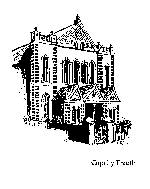
|
As we cross the railway down Railway Terrace we see the Congregational chapel, Jerusalem built in 1886. Proceeding down Mona Terrace we note the fine porticoed façade of the Calvinistic Methodist, Capel y Traeth built in 1895. At the entrance you can hear the waters of the Penpaled stream rushing down to the sea under the paving stones. Immediately after the chapel, is the cottage known as Penpaled built in 1820 on an estate of less than one acre and formerly owned by Ellis Nanney. Down at the seafront there was once a limekiln now no longer visible save in old postcards. Lime was apparently produced for export as well as for local use. Limestone for the kiln was unloaded from ships on the no longer existent quay across the road.
|
|
Crossing the road to the sea, there is a small green where community singing takes place on Sunday evenings throughout the summer. This spot was known as Pen Cei or Abermarchnad, where several cottages once stood until the terrible storm of 1927, which damaged them so badly they had to be demolished. Abermarchnad was the site of the old market of the original fishing village, all roads converging at this point, The herring industry was very important in the last century and dozens of horse drawn carts could be seen waiting together to be loaded with the catch from the sea, for transportation further afield.
|
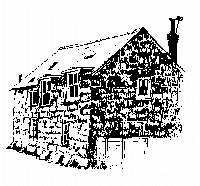
|
|
Westwards towards the Blue China café, we note a low stone building to its left which used to be the village mill in the sixteenth century. The round millstones apparently still lie in the floor. The millpond lay further up the hill, just south of the level crossing and approximately on the site of the present Pines Home for the elderly. It was fed by the Afon Cwrt, which turned the wheel, now no longer visible at this spot.
Leaving the mill we pass the Lifeboat station established in 1854. The lifeboat crew of seventeen are all volunteers who are summoned by maroons and flares. When they are summoned you may be able to witness the boat being launched down the slipway to the left of the jetty. As we go up the hill we see Lon Felin taking its name from the mill across the road. Next we have the pink-stuccoed "Foinavon" once owned by the Birds Custard family , the name apparently deriving from a Grand National winner of that name. Bearing right into Tanygrisiau Terrace, Number 7,"Morfin" was once the family home of David Lloyd George and was used as his office while practicing as a solicitor. Next we come across a fine mid sixteenth century house known as Ty Newydd "New house" originally built as the estate bailiffs dwelling. Fine views are enjoyed from here and the whole of Tanygrisiau Terrace across the bay towards Moel y Gest and Snowdon beyond.
Henbont Road is so named because Mrs Lewis of Talhenbont Hall donated the land on which Criccieths first council houses were built in order to rehouse the inhabitants of Pen Cei who were made homeless in the 1927 storm.
We now pass the Baptist Chapel, Berea built in 1886. The flat-roofed section of the house next door used to be a candle maker. A little further on there is a row of three houses thought to be about 600 years old, originally thatched. These are known as Wellington Terrace.
Re-tracing your steps along Tanygrisiau Terrace to Castle Street. Here stands Cadwalladers, nationally famous for its ice cream. It was always a family run firm, its first owner having a ready market for his ice cream, as he was father of thirteen children.
|
|
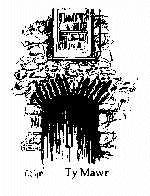
|
Climbing towards the castle we see the sixteenth century Ty Mawr, at one time the "Old Castle" public house. This is within the original town of Criccieth, Yr Hen Dref, as we climb we notice a long stone building now divided into three cottages opposite the castle, Porth yr Aur, Trefan and Cemlyn, dating back to 1700 and they mark the site of the original treasury of the castle. Cemlyn was reputedly used as the village church. Next stands the castle bakery, now a tearoom. There is a stained glass insertion above the shop window portraying bakers at their craft.
|
|
Opposite towers the castle, Criccieths main attraction. An excellent guide published by Cadw can be obtained at the ticket office.
Wonderful views can be obtained from the castle and just by the entrance, on the tiny green, Gardd y Stocs, the town stocks were placed.
|
|
|
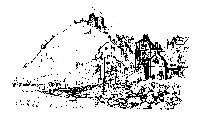
|
A weekly market used to be held in Market Square and political meetings too, Lloyd George's dramatic speeches are clearly remembered by former residents. The corner house used to be a butchers shop, which sold meat to Lloyd George's housekeeper, accompanied by his St Bernard dog, Ruffles. The shop on the opposite corner, which now sells paintings, was a cobblers and then a grocer.
|
|
Going down the back lane from Castle Square known as Lon Bach we pass three whitewashed fishermans cottages in Rock Terrace, Seawinds, formerly Ty Uchaf, Ty Canol and Ty Isaf, (highest, lowest and middle house) These three cottages date back to the sixteenth century.
Now we go down the Victorian Marine Terrace and beach, with its many small hotels and guest houses. At the far end we turn up Lon Fel, 'honey lane', with the once famous tennis club on the right. At the junction, turn right and walk down the High Street. We encounter the George IV Hotel built in 1830 and a series of long established shops dating back to the mid nineteenth century, among them being the Medical Hall (1875), Siop Newydd (1869) and Golden Eagle (1898).
|
|
Once back on the Maes we encounter the Lion Hotel built in 1731. It was here that the town councillors would repair after their court meetings in Cwrt. At that time it belonged to the mayor.
|
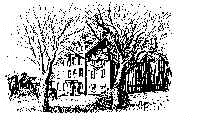
|
|
The Maes is green common land where markets were held on Thursdays as well as two annual fairs during the evangelical feasts of St Mark. The fairs still survive and are held in May and June when the whole of the Maes is transformed into a hubbub of stalls.
|
|
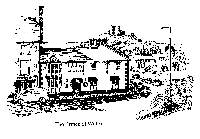
|
This brings us back to the Prince of Wales Public House and the Memorial Hall where we started this walk.
The above is a shortened version of the book "Criccieth, a Heritage Walk". Copies of the full version can be obtained at The Tourist Offices at Criccieth or Porthmadog at £1.50.
We acknowledge and thank the Eifionydd History Society for their permission to reproduce the above exerpts.
Further thanks and acknowledgement go to Peter Rodgers, Noel Hall and Owen Pritchard for the line drawings on this page.
|
|
|